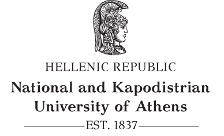- Αρχική
- THE PROGRAM
-
MODULES
- THE ARCHAEOLOGY OF BRONZE AGE AEGEAN (1010)
- KEY THEMES IN EASTERN MEDITERRANEAN ARCHAEOLOGY (1020)
- STATE FORMATION AND THE RISE OF POWER IN AN INSULAR WORLD: THE ARCHAEOLOGY OF MINOAN CRETE (3020)
- THE ARCHAEOLOGY OF MYCENAEAN GREECE (1050)
- COLLAPSE AND TRANSFORMATION: CRISIS, RESILIENCE, AND REORGANIZATION FROM THE LATE THIRD TO EARLY FIRST MILLENNIUM BCE IN THE EASTERN MEDITERRANEAN (3030)
- UNDERSTANDING THE ARCHAEOLOGICAL RECORD: PREHISTORIC CYPRUS AND THE EAST MEDITERRANEAN (2080)
- THE VISUAL CULTURES OF CLASSICAL GREECE (1030)
- ANCIENT GREEK SCULPTURE (1080)
- ATTIC POTTERY OF THE ARCHAIC AND CLASSICAL PERIODS (1090)
- THE ARCHITECTURE OF THE MYSTERY CULTS (2090)
- THE ARCHAEOLOGY OF DEATH IN THE ANCIENT GREEK WORLD (3010)
- STAFF
- ACTIVITIES
- ADMISSION
- RESOURCES
- CONTACT US
- NEWS AND EVENTS
THE VISUAL CULTURES OF CLASSICAL GREECE (1030)
Winter Semester, Core module, 10 ECTS
Instructor: Dimitris Plantzos
Summary
This course offers a comprehensive account of ancient Greek art, from c. 1200 to c. 30 BC, with an emphasis on its content, interpretation, and cultural significance. Several key themes will be pursued throughout the course: human figure and its representation; Greek art in its religious and political settings; materials and techniques; pictorial themes; and so on.
Besides the better-known monumental arts of ancient Greece (chiefly: architecture; sculpture; painting), and the ever-popular vase painting, the course will also cover some relatively neglected aspects of Greek art such as decorative or luxury arts and coinage. After a short introduction on the arts of the Late Bronze Age (c. 1600-1100 BC), the course will cover the art and archaeology of the Early Iron Age (c. 1100-700 BC), and that of the Archaic (c. 700-480 BC), Classical (. 480-336 BC) and Hellenistic periods (c. 336-30 BC).
Learning outcomes
By the end of this course students should be familiar with
- the main principles of Greek art
- the main methodologies employed in its study
- the main examples of Greek visual arts
- the contribution of Greek visual culture to our understanding of ancient Greece
They should also be able to
- assess different types and examples of ancient Greek material culture.
- discuss some main themes in the study of classical Greek art.
- critically assess some of the scholarly debates regarding classical Greek art and its development.
- comprehend the ways in which archaeology affects our understanding of past cultures.
- express their own scholarly views on the art and culture of ancient Greece.
Assessment
*Essay: 70%
Oral presentation: 10%
Written work: 20%
*Essay (3.500-5.000 words). A list of indicative topics is provided, but students are strongly encouraged to discuss and personalize the essay topic with the course instructor.
Student's study hours
Lectures: 50
Educational visits: 10
Study and analysis of bibliography: 50
Cooperation with the instructor: 10
Tutorials: 30
Independent study (incl. project): 50
Essay writing: 50
Course total: 250
Recommended bibliography
Required text books
Plantzos, D. Greek Art and Archaeology, 1200-30 BC. Athens 2016.
Smith, T.J. and D. Plantzos (eds). A Companion to Greek Art. Malden MA 2012.
Additional literature
Beard, M. and J. Henderson. Classical Art. From Greece to Rome. Oxford 2001.
Biers, W.R. The Archaeology of Greece. Ithaca & London 1996.
Boardman,J. Greek Art. London & New York 2016.
Hurwit, J.M. The Art and Culture of Early Greece. Ithaka & London 1985.
Knigge, U. The Athenian Kerameikos. Athens 1991.
Neer, R.T. Greek Art and Archaeology: A New History, c. 2500-c. 150 BCE. London & New York 2011.
Osborne, R. Greece in the Making 1200 – 479 BC. London 1996.
Pomeroy, S.B., S.M. Burnstein, W. Donlan, and J.T. Roberts. A Brief History of Ancient Greece. Politics, Society and Culture. Oxford 2004.
Plantzos, D. The Art of Painting in Ancient Greece. Athens and Atlanta, GA 2018.
Robertson, M. A History of Greek Art. Cambridge 1975.
Whitley, J. The Archaeology of Ancient Greece. Cambridge 2001.
